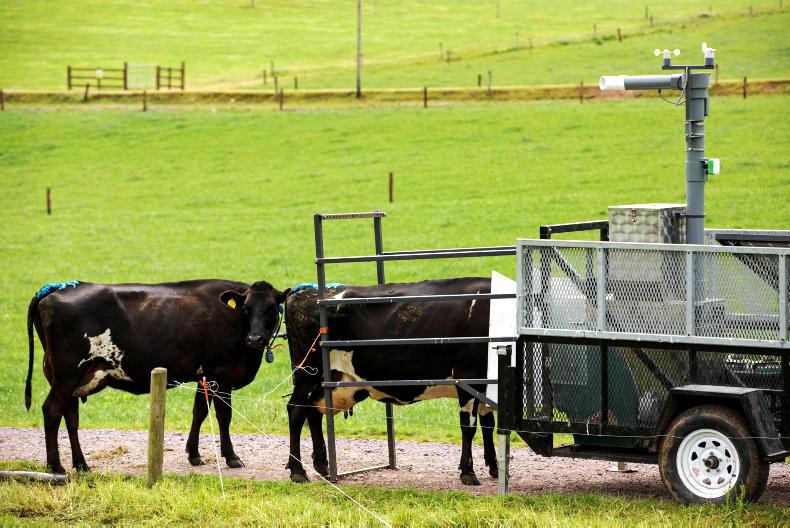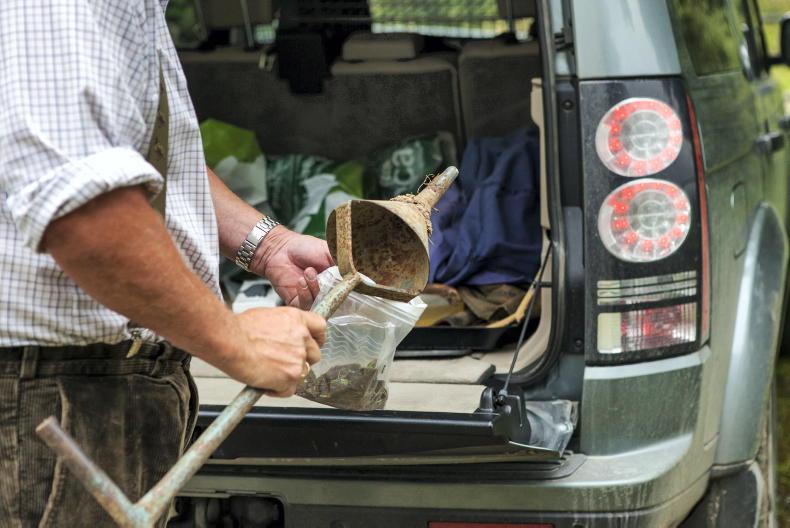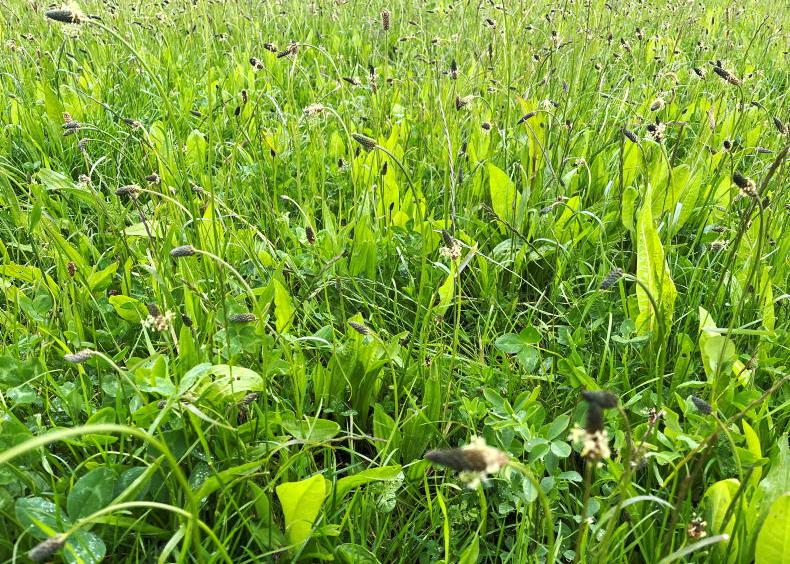Last November, the ICBF and Teagasc announced some fairly significant changes to the EBI, namely the introduction of a new carbon sub-index and a change in the way that the beef sub-index is calculated, among some other changes.
Farmers studying the EBI of an animal will now see carbon as a sub-index within the EBI, commanding a 10% overall weighting in the index. Changes to the weighting of the other sub-indices have also occurred, with the weighting on beef increasing from 8% to 10%, health going from 4% to 10% and calving going from 10% to 7%.
The relative emphasis on fertility, milk and maintenance has also declined but these traits are also captured in the new carbon sub-index. Between them, milk, fertility, carbon and maintenance sub-indices make up almost 70% of the relative emphasis in the new EBI.
Essentially, the carbon sub-index looks at all the traits that have an impact on carbon emissions and puts a monetary value on those emissions, currently €80/t of carbon dioxide. Cows that have a high carbon sub-index will be cows with good fertility, so they last a long time in the herd, will produce moderate levels of milk, won’t be very big (so will be efficient to maintain) and they will produce a calf that will be finished quickly and will grade well in the factory.

/ Donal O' Leary
So cows with a high carbon sub-index are going to produce less carbon dioxide equivalent than lower carbon sub-index cows. However, it’s important to clarify that genetically, it cannot be said that these high carbon sub-index animals produce any less methane gas than a lower carbon sub-index animal. It is more so that these high carbon sub-index animals express traits that help to reduce carbon emissions, such as good fertility and being able to produce early maturing offspring. Essentially, the carbon sub-index is a proxy measurement for methane emissions.
Finding animals that produce less methane is an ongoing project and while progress is being made, we are probably a number of years away from having enough reliable data to be able to introduce it into the EBI. When that does happen, the EBI will change again to reflect that. So, in essence, the carbon sub-index as we know it today is a stop-gap measure to use genetics to reduce carbon emissions until more reliable data is available.
According to the ICBF, early indications from animals whose actual methane emissions are being measured on machines show there is a strong correlation between the EBI sub-index for carbon and methane emissions.
The changes to beef are that a new trait in age-at-slaughter is being introduced to both the beef and carbon sub-index. This will reward animals that get to finishing weight in a shorter time than other animals because the longer a beef animal takes to finish, the more methane it produces, the more feed it eats, the more cost is incurred by the farmer and the less profit it can leave.
The new EBI has increased emphasis on carcase conformation and fat, but no real change is expected on carcase weight, with a slight decline in carcase weight from progeny of the dairy herd likely to continue.
At the time the new EBI was launched, ICBF said the economic value for carcase weight would need to be €7/kg in order for it to have a substantial impact. However, new in-spec requirements have been incorporated, so sires that produce carcases that are either too heavy or too light will be heavily hit. This penalty isn’t linear, with a 12c/kg penalty on carcases lighter than 250kg and a 45c/kg penalty on carcases lighter than 220kg.
This means that smaller carcases are going to be heavily penalised in the new EBI. This measure provides an important counterbalance to the maintenance sub-index, which is the size of the cow. Smaller cows will have a higher EBI for maintenance, but if they then produce offspring that have very small carcase sizes, their beef sub-index will be very low.
Carbon sub-index
Bulls that score highly in the carbon sub-index will have good fertility, moderate production and will be smaller in stature than the average animal. While high fat and protein is incentivised in the EBI, it is penalised in the carbon sub-index. So it’s a bit like cycling a bike down a hill and gently pressing the brakes at the same time – progress is still being made but not as much as without the brakes being applied.
Whereas when it comes to fertility, the carbon sub-index is like peddling faster when going down a hill. Therefore, bulls that are very high for milk and not so high for fertility and that also have a low maintenance sub-index will be heavily penalised in the carbon sub-index.
Flicking through the AI catalogues, the trend is very obvious in that cows that have a very high milk sub-index, nearly all have a very low carbon sub-index and vice versa. Most of the high-EBI genomic bulls are very high for fertility and moderate for production and these bulls will be have a carbon sub-index of €10-€15. At just 10% of the EBI, the carbon sub-index doesn’t have a huge influence over the overall EBI of an animal, but it does give a good sense of how that animal will stack up in terms of carbon emissions.
Beef sub-index
It could be argued that the changes to the beef sub-index are more tangible than the new carbon sub-index in that the data being used definitely has an impact on beef output.
The traits being used in the beef sub-index are categorised into two areas: age-at-slaughter and in-spec. Bulls that are likely to produce animals that are in spec for carcase weight, conformation and fat score will have a higher EBI for beef, while animals that get to slaughter at an earlier date will also score well on the beef sub-index.
The criticism of the changes is that they won’t necessarily improve the carcase size coming from the dairy herd. Animals that are outside of the carcase weight specification will be heavily penalised in the EBI, but there is no bonus for heavier carcases over lighter carcases once they are in-spec. From 2021-2022, over 24% of animals from the dairy herd with a dairy sire were slaughtered with a carcase size lighter than 280kg.
A lot of the focus has shifted to age-at-slaughter, with earlier-finishing animals having a higher EBI than later-finishing animals. While this has obvious advantages from a climate perspective in lowering methane emissions, it also lowers the costs for farmers.
However, the potential downside is that as age-at-slaughter gets lower, it may also mean that carcase size gets smaller, creating a negative impact on profit potential.
Last November, the ICBF and Teagasc announced some fairly significant changes to the EBI, namely the introduction of a new carbon sub-index and a change in the way that the beef sub-index is calculated, among some other changes.
Farmers studying the EBI of an animal will now see carbon as a sub-index within the EBI, commanding a 10% overall weighting in the index. Changes to the weighting of the other sub-indices have also occurred, with the weighting on beef increasing from 8% to 10%, health going from 4% to 10% and calving going from 10% to 7%.
The relative emphasis on fertility, milk and maintenance has also declined but these traits are also captured in the new carbon sub-index. Between them, milk, fertility, carbon and maintenance sub-indices make up almost 70% of the relative emphasis in the new EBI.
Essentially, the carbon sub-index looks at all the traits that have an impact on carbon emissions and puts a monetary value on those emissions, currently €80/t of carbon dioxide. Cows that have a high carbon sub-index will be cows with good fertility, so they last a long time in the herd, will produce moderate levels of milk, won’t be very big (so will be efficient to maintain) and they will produce a calf that will be finished quickly and will grade well in the factory.

/ Donal O' Leary
So cows with a high carbon sub-index are going to produce less carbon dioxide equivalent than lower carbon sub-index cows. However, it’s important to clarify that genetically, it cannot be said that these high carbon sub-index animals produce any less methane gas than a lower carbon sub-index animal. It is more so that these high carbon sub-index animals express traits that help to reduce carbon emissions, such as good fertility and being able to produce early maturing offspring. Essentially, the carbon sub-index is a proxy measurement for methane emissions.
Finding animals that produce less methane is an ongoing project and while progress is being made, we are probably a number of years away from having enough reliable data to be able to introduce it into the EBI. When that does happen, the EBI will change again to reflect that. So, in essence, the carbon sub-index as we know it today is a stop-gap measure to use genetics to reduce carbon emissions until more reliable data is available.
According to the ICBF, early indications from animals whose actual methane emissions are being measured on machines show there is a strong correlation between the EBI sub-index for carbon and methane emissions.
The changes to beef are that a new trait in age-at-slaughter is being introduced to both the beef and carbon sub-index. This will reward animals that get to finishing weight in a shorter time than other animals because the longer a beef animal takes to finish, the more methane it produces, the more feed it eats, the more cost is incurred by the farmer and the less profit it can leave.
The new EBI has increased emphasis on carcase conformation and fat, but no real change is expected on carcase weight, with a slight decline in carcase weight from progeny of the dairy herd likely to continue.
At the time the new EBI was launched, ICBF said the economic value for carcase weight would need to be €7/kg in order for it to have a substantial impact. However, new in-spec requirements have been incorporated, so sires that produce carcases that are either too heavy or too light will be heavily hit. This penalty isn’t linear, with a 12c/kg penalty on carcases lighter than 250kg and a 45c/kg penalty on carcases lighter than 220kg.
This means that smaller carcases are going to be heavily penalised in the new EBI. This measure provides an important counterbalance to the maintenance sub-index, which is the size of the cow. Smaller cows will have a higher EBI for maintenance, but if they then produce offspring that have very small carcase sizes, their beef sub-index will be very low.
Carbon sub-index
Bulls that score highly in the carbon sub-index will have good fertility, moderate production and will be smaller in stature than the average animal. While high fat and protein is incentivised in the EBI, it is penalised in the carbon sub-index. So it’s a bit like cycling a bike down a hill and gently pressing the brakes at the same time – progress is still being made but not as much as without the brakes being applied.
Whereas when it comes to fertility, the carbon sub-index is like peddling faster when going down a hill. Therefore, bulls that are very high for milk and not so high for fertility and that also have a low maintenance sub-index will be heavily penalised in the carbon sub-index.
Flicking through the AI catalogues, the trend is very obvious in that cows that have a very high milk sub-index, nearly all have a very low carbon sub-index and vice versa. Most of the high-EBI genomic bulls are very high for fertility and moderate for production and these bulls will be have a carbon sub-index of €10-€15. At just 10% of the EBI, the carbon sub-index doesn’t have a huge influence over the overall EBI of an animal, but it does give a good sense of how that animal will stack up in terms of carbon emissions.
Beef sub-index
It could be argued that the changes to the beef sub-index are more tangible than the new carbon sub-index in that the data being used definitely has an impact on beef output.
The traits being used in the beef sub-index are categorised into two areas: age-at-slaughter and in-spec. Bulls that are likely to produce animals that are in spec for carcase weight, conformation and fat score will have a higher EBI for beef, while animals that get to slaughter at an earlier date will also score well on the beef sub-index.
The criticism of the changes is that they won’t necessarily improve the carcase size coming from the dairy herd. Animals that are outside of the carcase weight specification will be heavily penalised in the EBI, but there is no bonus for heavier carcases over lighter carcases once they are in-spec. From 2021-2022, over 24% of animals from the dairy herd with a dairy sire were slaughtered with a carcase size lighter than 280kg.
A lot of the focus has shifted to age-at-slaughter, with earlier-finishing animals having a higher EBI than later-finishing animals. While this has obvious advantages from a climate perspective in lowering methane emissions, it also lowers the costs for farmers.
However, the potential downside is that as age-at-slaughter gets lower, it may also mean that carcase size gets smaller, creating a negative impact on profit potential.











SHARING OPTIONS